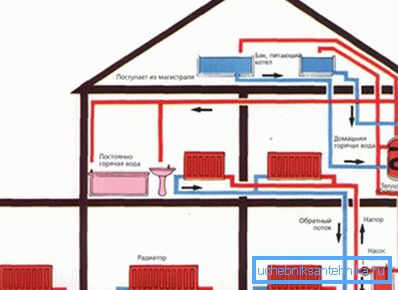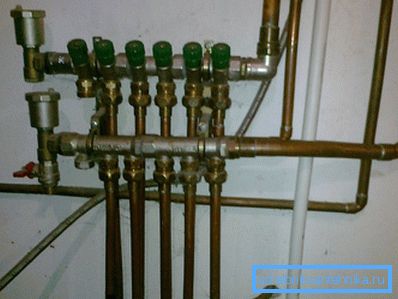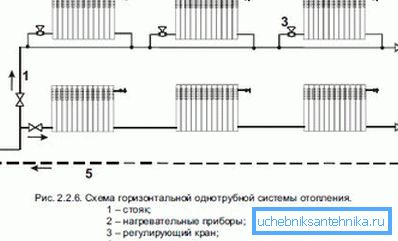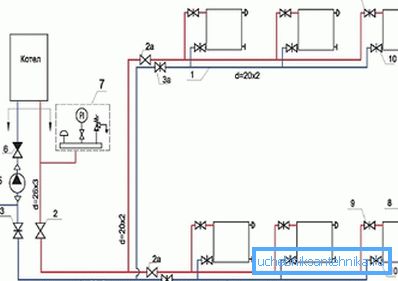The heating scheme of a two-story house with forced
Nowadays there are a lot of options for laying heating communications, but all of them can be divided into several main groups that have differences in design and work efficiency. In this article, we will look at the most popular options, highlight their main advantages and address the shortcomings. After reading the information outlined below, you can easily determine which type will be optimal for your conditions.

The most popular types of systems
Best in the process of exploitation themselves recommended the following options:
| Contours with natural circulation | A couple of decades ago, there was simply no alternative to this species. Such options are good for their simplicity and unpretentiousness, but they have a whole lot of flaws, which will be discussed in the next chapter. |
| Single pipe systems | A more advanced option, which is quite simple to install, which is important when doing work with your own hands. In addition, this type of communication allows you to save materials, therefore, the price of the project is lower. But this option has a lot of minuses |
| Two-pipe systems | The presence of two lines and separate coolant inlets to each radiator allows for more uniform heat transfer, which increases efficiency. The cons can be attributed to the consumption of materials and the inability to hide communication |
| Collector Communications | It is safe to say that this option is the most perfect and effective today. Features of the wiring ensure uniform flow of coolant to all heating elements |

Tip! Do not trust the opinion of experts who claim that one or the other option is better than others. Many of them are constantly doing the same types of communications and simply do not want to collect the same collector, as they have little knowledge of its structure.
Advantages and disadvantages of each type
Consider each option deployed to understand how they differ from each other. It is necessary to take into account not only the cost and complexity of installation work, but also the effectiveness of the work later. Cheap build options are often less efficient to use, which causes energy waste.
Communications with gravity movement of the coolant
The heating scheme of a two-story house with natural circulation has some differences from similar options in single-story buildings.
Consider the most important nuances that everyone should know about:

- On the second floor there is a mandatory expansion tank, the volume of which is calculated individually, based on the capacity of the system. It can be located both in the attic and in any room, the main thing is that the container is located at the top of the entire system.
- All pipelines should be laid with a slope of 3 to 5 degrees to ensure the movement of the coolant.
Note! You should not forget that the return pipeline is made of pipes, the diameter of which should increase as it gets closer to the heat unit, this will ensure excellent circulation.
- The upper pipe can be laid both under the ceiling and under the window sills.
The advantages include complete autonomy and independence from energy, as well as ease of maintenance and noiseless operation. Among the shortcomings, we note the complexity of installation, the impossibility of working in large areas (over 130 m2), uneven space heating and the need for constant monitoring of the coolant level.
Single tube version

The main differences of this option are the following factors:
- Low material consumption, since much less pipes are required, the cost of the project accordingly decreases, which is an important factor.
- Valves are placed on the branches to each radiator, This allows you to turn off unnecessary heating points or remove them for repair if necessary.
- It is also advisable to make a bypass line., This will ensure uniform heating of all elements.
From the advantages, it is possible to single out simplicity and cost-effectiveness, from the minuses - uneven heating with distance from the boiler and the need to set up the system.
Two-pipe heating
The heating system of a two-story house with the forced circulation of a two-pipe type is a more perfect option, which has a number of advantages:
- Radiator heating more uniform, thereby increasing the efficiency of the system.

- The presence of a circulating pump in the heating system ensures a constant flow of fluid, regardless of temperature..
- The delivery pipe can be located either under the ceiling or under window sills or even near the floor..
It can be said that this option is the most popular among developers, however, recently a more advanced type is gaining more and more distribution, which we will consider in the next chapter.
Collector system

Many people mistakenly believe that this option can only be installed by professionals.
Meanwhile, the instruction for laying communications of this type is quite simple and includes the following steps:
- Calculation of the number of heating points, it is important when choosing a heating collector, since it should contain as many conclusions as radiators in the house.
Note! Using the collector option allows you to include in the system and a warm floor, for it is allocated a separate circuit, and no extra work is required.
- The distributor is located in the boiler room, a separate pipe is led from it to each radiator. This allows you to control each circuit separately.
- You can leave a few backup pins in case of adding radiators or laying a heated floor.

The only disadvantage is the laying of a large number of pipes, and the drawbacks are exhausted there.
Conclusion
Competent choice of the heating system is very important, as high-quality heating is the key to the comfort of living in a dwelling.